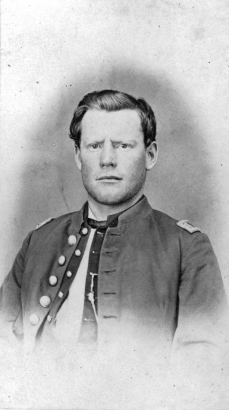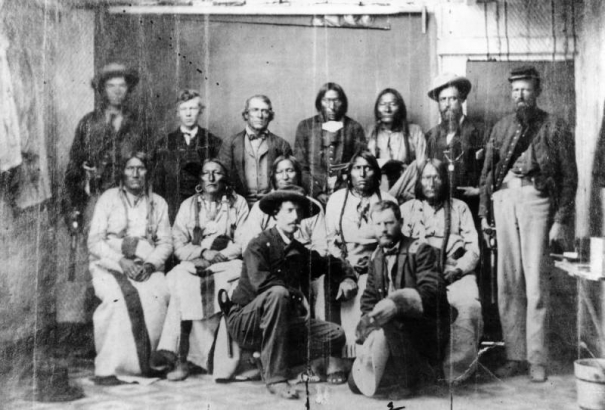The Skyline Park area of downtown Denver certainly has plenty to occupy visitors – from the park itself, to people-watching on the Sixteenth Street Mall, to the iconic Daniels and Fisher Tower. One item that might escape notice is a plaque on the second pillar of the office building on the corner of 15th and Arapahoe. But the story behind this plaque details one of Colorado’s bloodiest chapters – and one of its unsung heroes.
April 1865 was a dark month for the city of Denver. On the fourteenth, the President of the United States had been murdered. Colorado, eleven years from statehood, was a territory overwhelmingly sympathetic to the Union. News of Lincoln’s assassination shook the city to its core. Scarcely over a week later, one of Denver’s own - a charismatic cavalry captain named Silas Soule - was murdered in the street.
While the news of Soule’s demise was horrifying, it did not come as a surprise. Soule himself had predicted his assassination numerous times, including the day before his death.
Silas Soule (pronounced “soul”) was only twenty-six at the time of his murder, but he was no stranger to controversy. Born to anachronistically progressive parents on the East Coast, Silas spent his childhood in a utopian colony raised with the radical ideals of gender and racial equality.
The Soules moved to Kansas in the mid-1850s to help sway the territory into becoming a free rather than slaveholding state. They became close friends of abolitionist John Brown, and their home in Lawrence, Kansas, was an important stop on the Underground Railroad.
By 16, Silas was working as a conductor on the Underground Railroad, leading escaped slaves between Underground Railroad stops into freedom. It was extremely dangerous work, as conductor and slaves were always at risk of imprisonment or death.
Fighting between abolitionists and slaveholders in Kansas - a precursor to the Civil War - was so violent that the territory was commonly referred to as “Bleeding Kansas." Silas joined the Jayhawkers, the name given to Kansas' abolitionist militia.
He quickly rose through the ranks and was involved in several high-profile prison breaks, including the escape of Underground Railroad conductor John Doy and an attempted prison break of John Brown in Harper’s Ferry, Virginia. Brown refused help and was sentenced to death, an event which helped spark the Civil War.
The Soules warned their son not to return to Kansas after the events at Harper’s Ferry. At 19, he was already a notorious guerilla fighter with a bounty on his head.
Silas eventually made his way to Colorado, where his older brother had found success as a miner.
In 1861, the tensions that had been brewing so long in Kansas and elsewhere boiled over into all-out war. The Colorado territory quickly raised a volunteer army, the Colorado First Regiment, to fight on the side of the Union. Silas enlisted and became a First Lieutenant, due to his many years of experience with the Jayhawkers.
On March 28, 1862, the Colorado First Regiment successfully repelled a Confederate attempt to cross into Colorado and New Mexico territory. The Battle of Glorieta Pass prevented Confederate influence from spreading into the West. In recognition, the Union promoted the Colorado First Regiment to an official United States Cavalry unit.
Silas Soule was promoted to captain in recognition of his tactical skill and calm under fire. Major John Chivington, the “fighting preacher” from Ohio, earned a promotion to Colonel at the head of the Colorado Cavalry.
At the same time that war had broken out throughout the United States proper, the territories faced the prospect of an additional war with the various tribes who were displaced by settlers.
Chivington and Soule, along with Major Edward Wynkoop and territorial governor John Evans, were involved in several peace talks between the United States and two of Colorado’s most powerful tribes, the Cheyenne and Arapaho. In late 1864, the United States had come to a tentative peace with the two tribes at the Camp Weld Council.
Wynkoop and Soule, both sympathetic to the Cheyenne and Arapaho, viewed the council as a victory. Unbeknownst to them, Evans and Chivington were already devising a plan to eliminate the “Indian problem” once and for all.
On November 28, 1864, Colonel Chivington approached his troops with the news that the Cheyenne and Arapaho were planning a surprise attack on United States forces. He explained that a preemptive strike was the only way to prevent disaster.
Silas Soule soon realized that Chivington did not have any information about an attack. Instead, he was planning a raid on the peaceful encampment at Sand Creek, where the wives, children, and elderly of the Cheyenne and Arapaho tribes were living while warriors attended the Camp Weld Council.
“I was indignant as you would have been were you here,” Soule wrote to his close friend Wynkoop, who had been called away to help negotiate a trade of Native American and white prisoners. “[I] told them that any man who would take part in the murders, knowing the circumstances as we did, was a low lived cowardly son of a bitch.”
Chivington did not take this criticism well, and threatened to have Soule hanged. Silas continued with his protests, and the next day refused to allow his men to obey Chivington’s orders to attack the village.
He threatened to personally shoot any man who followed the order, and instead had his company attempt to block the attack. Other captains took a lead from Soule and refused to allow their men to fight. Despite their efforts, over one hundred and fifty women, children and elderly were murdered at Sand Creek. He vividly recounted his experience in a now famous letter to Wynkoop.
Chivington was determined to brand the massacre as an important victory for the United States, but Soule wrote letters to influential congressmen in Washington, describing the truth of what happened that day. He convinced others to write letters as well, documenting the true horror of the experience.
His campaign was successful enough that an inquiry was launched into the massacre at Sand Creek. Chivington cast Soule as a coward and a traitor to white Americans, while Silas described the graphic violence he had witnessed against the defenseless members of the two tribes.
Nothing ever came of the investigation – Chivington’s contract with the military expired, making him ineligible for court martial. His reputation as a war hero after the Battle of Glorieta Pass protected him for criminal prosecution.
However, Silas Soule destroyed Chivington’s political aspirations with his testimony. Chivington, nicknamed “The Butcher of Sand Creek” until his death, was not shy about his desire for revenge on the young captain.
Soule wanted to put the horror of Sand Creek to rest. He did not reenlist with the Colorado Cavalry when his contract expired, instead taking a position as provost marshal (head of military police) in Denver.
He married his longtime sweetheart, nineteen-year-old Hersa Coberly (daughter of legendary saloon owner Sarah Coberly), on April 1, 1865. Just three weeks after her wedding, Hersa found herself a widow.
On the night of April 23, the pair were returning home when a gunshot sounded a few blocks away. Silas sent his wife home, and went to investigate the noise. Waiting for him in a dark alley at what is now 15th and Arapahoe were two assassins.
Silas, who had been prepared for an attempt on his life since his testimony against Chivington, shot at one of his assailants at the same time as the other man shot him. Soule was killed instantly by a bullet to the head.
The assassins, men who had served under Chivington, were captured but escaped before trial – likely aided by others loyal to Chivington. It was believed that Chivington had hired the assassins to murder Soule, but it was never proven.
For many years, Silas Soule and his contributions to the memory of the Sand Creek Massacre were forgotten.
In 2010, the marker commemorating Soule’s death was placed by the Colorado Historical Society on the second pillar of what is now the large building next to Skyline Park. At the annual Healing Run undertaken by descendants of those killed at the Sand Creek Massacre, the Cheyenne and Arapaho stop at both the memorial plaque in downtown Denver and at Silas Soule’s grave at Riverside Cemetery to pay their respects.
The next time you find yourself in the Lower Downtown area, take a moment to look at the marker and remember Silas Soule, who was killed on that same spot over one hundred and fifty years ago.
If you are interested in researching more about Silas Soule, the Western History and Genealogy Department has manuscript collections from both Silas Soule and John Chivington, along with the only full biography of Soule: Silas Soule, a Brief Life of Moral Courage.




Comments
Re "Chivington and Soule,
Re "Chivington and Soule, along with Major Edward Wynkoop and territorial governor John Evans, were involved in several peace talks between the United States and two of Colorado’s most powerful tribes, the Cheyenne and Arapaho."
John Evans was not only Territorial Governor, but he was concurrently appointed the Territorial Superintendent of Indian Affairs (an unusual arrangement -- generally in the mid-19th century West, different people held those offices). Though Evans was not In Colorado at the time of the massacre, Soule and others' denunciation of Chivington's war crimes perpetrated on Evans' watch prompted Lincoln to demand (and receive) Evans' resignation from the two posts.
Thank you for commenting and
Thank you for commenting and for sharing this additional history!
Loved the story! Sad but
Loved the story! Sad but intriguing.
Thank you for reading, Jim!
Thank you for reading, Jim!
Thanks for sharing this
Thanks for sharing this remarkable story. Next time I'm at Riverside Cemetery I'll be sure to lay some flowers at his grave.
Thank you for reading!
Thank you for reading!
Thank you for sharing this
Thank you for sharing this story. I have never seen this plaque and can't wait to tell this piece of Colorado history to friends next time I'm downtown.
Thank you for commenting,
Thank you for commenting, Allen! Do be sure to check out the plaque next time you are downtown!
Fascinating and sad history.
Fascinating and sad history. Thank you for sharing it.
Thank you for reading, Jane!
Thank you for reading, Jane!
Add new comment